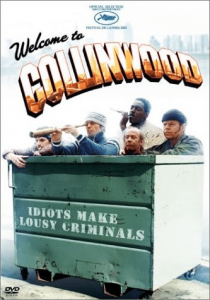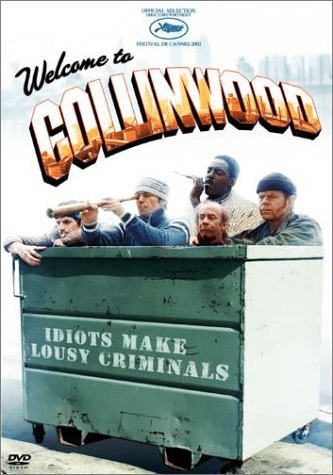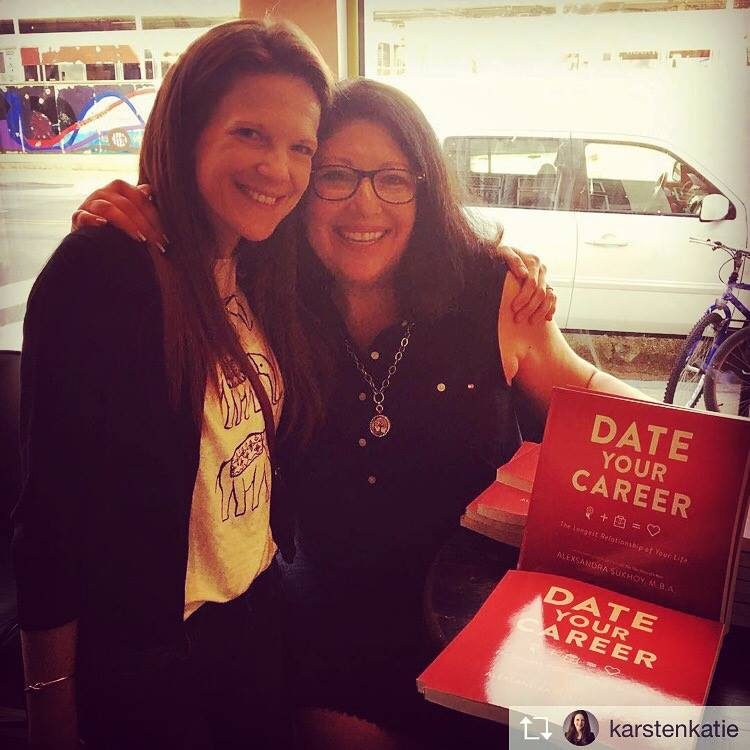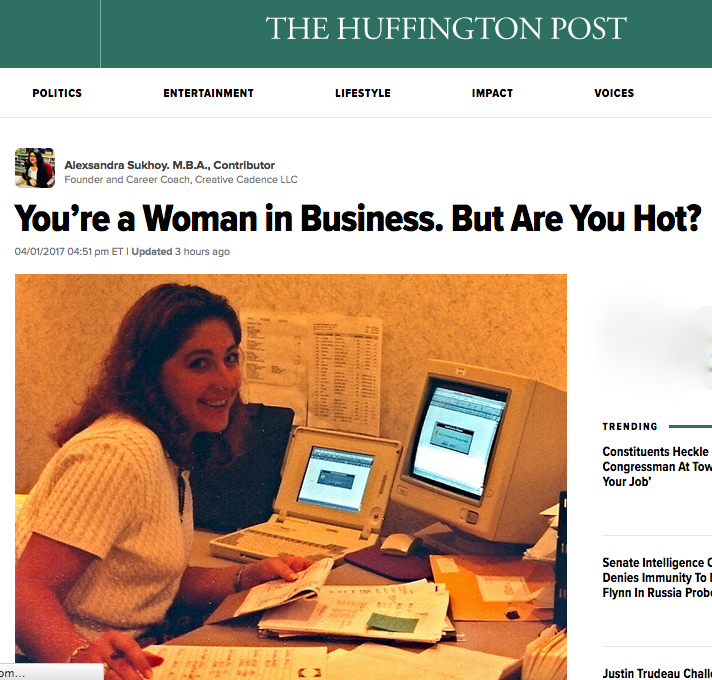- Begin Your Growth Plan Today!
- (216) 410-3825
- info@creativecadence.com
Cleveland in Film: The Era of Dysfunction
By Ben Lieblich and Alex Sukhoy 
Films of the period reflected the ethos. Whether it was a family at first divided by rock and roll and then redeemed by it (“Light of Day”), or a baseball team in which players subsumed their individual goals for the good of the franchise (“Major League” and “Major League II”), the depiction was of flawed but proud people who would do whatever it took to overcome a challenge. The same could almost be said of “Howard the Duck,” except that, in that particular special effects vehicle, one extraterrestrial duck teamed with the scrappy Clevelanders to save the world. We choose to overlook this technicality.
While Cleveland was enjoying its role as underdog in the movies, Woody Allen was busy perfecting his portrayal of New Yorkers as the most dysfunctional people on the planet. In 1977, the director, whose oevre to date had encompassed only the supremely ridiculous, released a romantic comedy built around Groucho Marx’s comment, “I would never want to belong to any club that would have someone like me for a member.” “Annie Hall,” based loosely on the real-life relationship between its stars, managed a delicate balance between wistfulness and hilarity. It won the Academy Award for best picture, and Allen scooped up Oscars for writing and directing. He spent the next twenty-five years making movies set in New York, featuring family meltdown, compulsive adultery, narcissism, Oedipal relationships, and criminals both bungling and lethally competent. Dysfunction was the recurring animating principal of Allen’s characters. And when the audience watched, it accepted these over-intellectualizing, infantile, id-driven people as an integral component of the New York landscape, as if the city’s drinking water had poisoned Manhattanites into rejecting rational perspective.
 But something funny happened at the turn of the millennium. Whether because of New York’s economic revival, the September 11 attacks, or a culture in which Donald Trump trounces “Ugly Betty” in the ratings, Woody Allen came to realize that the dysfunctional New Yorker stereotype had run its course. Thus, during the last several years, his career has drawn new breath from films set overseas (“Match Point” and “Vicky Cristina Barcelona”) in which naive, properly functioning Americans are dominated and ruined by egomaniacal Europeans. A gap was created. Where would Americans find a city in which dysfunction could be accepted as elemental? Out of nowhere, Cleveland rushed to fill the void.
But something funny happened at the turn of the millennium. Whether because of New York’s economic revival, the September 11 attacks, or a culture in which Donald Trump trounces “Ugly Betty” in the ratings, Woody Allen came to realize that the dysfunctional New Yorker stereotype had run its course. Thus, during the last several years, his career has drawn new breath from films set overseas (“Match Point” and “Vicky Cristina Barcelona”) in which naive, properly functioning Americans are dominated and ruined by egomaniacal Europeans. A gap was created. Where would Americans find a city in which dysfunction could be accepted as elemental? Out of nowhere, Cleveland rushed to fill the void.Much as “Annie Hall” heralded an era of dysfunctional New Yorkers on film, “American Splendor,” released in 2003, appears to have done the same for Clevelanders. The films are similar in both theme and narrative structure. Both feature anti-social protagonists who tell their own stories. Both films feature brief animation sequences, portrayals of the central characters by themselves and by actors, and moments in which character is broken and the audience is addressed directly. Everything is done to give viewers a multi-faceted view of two dyspeptic men – Alvy Singer in “Annie Hall” and Harvey Pekar in “American Splendor” – who push people away yet remain lovable while doing so.
“American Splendor” is based on the story of real-life local curmudgeon Harvey Pekar, a misfit everyman who experiences a rush of inspiration while waiting behind an old lady in a cash register line. He conceives of a comic book series in which the central character, Harvey himself, grouses about everyday experiences – like waiting in line behind slow-moving old ladies. Harvey is made rueful and dysfunctional by his outsized reactions to the minor annoyances of everyday life. His genius is that he knows it. The irony of “American Splendor” is that the more splenetic and dysfunctional Harvey becomes, the more comic books he sells. The film shows Cleveland to be dingy, full of greys and browns, and it captures none of the city’s beauty. But Harvey loves it anyway, just as he loves his unkempt, uncool friends. Harvey’s wife, Joyce Brabner, claims, “I find most American cities to be depressing in the same way.” What is special about Harvey is that he finds Cleveland depressing in a unique way, and that is why he clings so tightly to his relationship with his home town.
 Over the past ten years or so, a series of films have taken elements from “American Splendor” and examined them from different angles. Anger, madness and violence all crop up in a pair of films that are also drawn from real life. “Antwone Fisher” tells the tale of a compulsively violent sailor who was subjected to physical, emotional and sexual abuse while growing up in Cleveland. “The Soloist” is based on the story of talented musician Nathaniel Ayers, who grew up in a loving home in Cleveland but began a descent toward schizophrenia as a young student at the Juilliard School in New York. In neither film is any line explicitly drawn between Cleveland and dysfunction. But the question must be asked: in each of these movies about redemption, why is the city mentioned at all? It plays no role in the primary narrative. The inclusion of Cleveland in the story line implies that the city is a garden in which the seeds of madness routinely sprout.
Over the past ten years or so, a series of films have taken elements from “American Splendor” and examined them from different angles. Anger, madness and violence all crop up in a pair of films that are also drawn from real life. “Antwone Fisher” tells the tale of a compulsively violent sailor who was subjected to physical, emotional and sexual abuse while growing up in Cleveland. “The Soloist” is based on the story of talented musician Nathaniel Ayers, who grew up in a loving home in Cleveland but began a descent toward schizophrenia as a young student at the Juilliard School in New York. In neither film is any line explicitly drawn between Cleveland and dysfunction. But the question must be asked: in each of these movies about redemption, why is the city mentioned at all? It plays no role in the primary narrative. The inclusion of Cleveland in the story line implies that the city is a garden in which the seeds of madness routinely sprout.Shifting to a lighter tone, the Cleveland genre we most enjoy is the comedy in which characters, like Harvey Pekar, embrace, mock, and wallow in their dysfunction. In “The Oh in Ohio,” released in 2006, Parker Posey plays Priscilla, a woman suffering from sexual dysfunction. The plot is propelled by her quest to receive love, and orgasms, from a man. Drawing on her work in 1995’s “Party Girl” – in which she played a woman breezily indifferent to adult responsibility, and set, of course, in New York – Posey gives us a Priscilla who, rather than finding misery in her situation, sees the humor in it. “The Oh in Ohio” is quite consciously Cleveland-based, with shots from around the city, particularly the Coventry neighborhood. Filmed at night and in the bright sunshine, the city sparkles under both treatments. Of course, this is a metaphor for Priscilla herself, who refuses to let life’s disappointments diminish her joy. Here is a Clevelander redefining what it means to be tough. Directionless, at war with her sexuality, and in a failing marriage, Priscilla is strong enough to smile when she should be crying. Posey and Cleveland each make the most of their roles.
 In “The Rocker,” Rainn Wilson, of “The Office,” is Robert “Fish” Fishman, a man haunted, like Harvey Pekar, by what might have been. So haunted is he, in fact, that he refuses to grow up. Expelled from a 1980s glam group just before it hits stardom, Fish waits twenty years before he lands his next gig, as the drummer for his nephew’s high school band. Determined to wring every ounce of pleasure from his second chance at glory, Fish dives from stages, drinks to excess, destroys hotel rooms and refuses to accept any level of adult responsibility. He remains likable only because of his desperate insistence that foolish behavior is the essence of joy. Here, again, a Clevelander is shown whose life is comically sad, and who is in on the joke. The Cleveland shots are drawn to show contrasts. The Rock and Roll Hall of Fame – to which Fish aspires – is counterpoised against the real world he inhabits: his sister’s remodeled pre-war house, which appears to be in Tremont or Ohio City, where Fish lives in the further juxtaposed cluttered and un-updated attic. As in “American Splendor” and “The Oh in Ohio,” the setting works as a place where only the tough survive, and where a sense of humor is the measure of toughness.
In “The Rocker,” Rainn Wilson, of “The Office,” is Robert “Fish” Fishman, a man haunted, like Harvey Pekar, by what might have been. So haunted is he, in fact, that he refuses to grow up. Expelled from a 1980s glam group just before it hits stardom, Fish waits twenty years before he lands his next gig, as the drummer for his nephew’s high school band. Determined to wring every ounce of pleasure from his second chance at glory, Fish dives from stages, drinks to excess, destroys hotel rooms and refuses to accept any level of adult responsibility. He remains likable only because of his desperate insistence that foolish behavior is the essence of joy. Here, again, a Clevelander is shown whose life is comically sad, and who is in on the joke. The Cleveland shots are drawn to show contrasts. The Rock and Roll Hall of Fame – to which Fish aspires – is counterpoised against the real world he inhabits: his sister’s remodeled pre-war house, which appears to be in Tremont or Ohio City, where Fish lives in the further juxtaposed cluttered and un-updated attic. As in “American Splendor” and “The Oh in Ohio,” the setting works as a place where only the tough survive, and where a sense of humor is the measure of toughness.Cleveland’s own Anthony and Joe Russo wrote and directed “Welcome to Collinwood,” a film set, naturally, in North East Ohio’s neighborhood of the same name. The film’s tag line “Idiots make lousy criminals” establishes the tone and theme of the story, in which an impressive cast – including George Clooney, William H. Macy, Isaiah Washington, Sam Rockwell, Luiz Guzman, Michael Jeter and Patricia Clarkson – behaves in very unimpressive ways. The characters are all down-on-their-luck hooligans in pursuit of one big score (in their parlance, a Bellini), and all they need to pull it off is a fall-guy (a Mullinski) who is even further down the food chain than they are. In one of the most memorable and symbolic scenes, William H. Macy’s character, a pallbearer at his friend’s funeral, carries the coffin with one hand while supporting his baby son with the other: the circle of life complete. None of the characters has any money, direction or hope. This is the greatest dysfunction of all: the sure knowledge that opportunity has passed, and now there is no escape, not from one’s life and definitely not from one’s geography. As the movie title itself implies, like the famous lyric of that great Eagles’ song, “You can check out any time you like, but you can never leave.”
Even on television, the theme of Cleveland as the home of dysfunction plays well. Harvey Pekar’s friend Toby Radloff, described in “American Splendor” as “borderline autistic,” became a minor celebrity when MTV chose him to host spring break from his Cleveland home. While beautiful boys and girls frolicked in the sun in Florida, the unlovely Radloff, a self-professed uber-nerd, narrated the action from beside his plastic above-ground pool 1,200 miles away. By making it unclear whether Radloff was really in on the joke, or whether he was letting MTV pick on him, the producers created compelling television. Toby appeared happy simply to have his fifteen minutes of fame, no matter how he got them. In another story of redemption-by-dysfunction, the Rock and Roll Hall of Fame, after twenty-five years of snubbing the city that holds its home, in 2009 finally decided that Cleveland was worthy of hosting the Hall’s annual induction ceremony – on a rotating basis. Grateful for recognition, willing to forgive and recognizing that a slice of pie is better than none at all, the city put on a high-production and memorable show as well as accommodating music royalty in Cleveland’s high-end hotels and restaurants.
 All of this attention, even if most of it has been tongue-in-cheek, seems to have sparked interest in Cleveland as an entertainment hub. A new generation of home-grown talent is starting to make waves. Consider the Russo brothers, whose NBC television show “Community” is a big hit, or the underground television program “Julio” from Hot Lather Productions. Artists from around the country are discovering a new home in the city. For example, Judah Friedlander (“30 Rock”), the trucker-hat-wearing, go-to actor for socially awkward characters, played Toby Radloff to critical acclaim in “American Splendor” and returns to Cleveland from time to time to visit with Toby and to perform at Hilarities. Jeff Garlin, best known for his work in the dysfunction-centric “Curb Your Enthusiasm,” stole the scenes in “The Rocker” and also returns for standup gigs. Drew Carey, who recently produced a web-based documentary show about Cleveland called “Reason Saves Cleveland with Drew Carey!” returned home at the invitation of Council President Martin Sweeney in order to share his views on transformative initiatives in the city. Even comedy legend Betty White will be starring in a new TV Land sitcom called “Hot in Cleveland.”
All of this attention, even if most of it has been tongue-in-cheek, seems to have sparked interest in Cleveland as an entertainment hub. A new generation of home-grown talent is starting to make waves. Consider the Russo brothers, whose NBC television show “Community” is a big hit, or the underground television program “Julio” from Hot Lather Productions. Artists from around the country are discovering a new home in the city. For example, Judah Friedlander (“30 Rock”), the trucker-hat-wearing, go-to actor for socially awkward characters, played Toby Radloff to critical acclaim in “American Splendor” and returns to Cleveland from time to time to visit with Toby and to perform at Hilarities. Jeff Garlin, best known for his work in the dysfunction-centric “Curb Your Enthusiasm,” stole the scenes in “The Rocker” and also returns for standup gigs. Drew Carey, who recently produced a web-based documentary show about Cleveland called “Reason Saves Cleveland with Drew Carey!” returned home at the invitation of Council President Martin Sweeney in order to share his views on transformative initiatives in the city. Even comedy legend Betty White will be starring in a new TV Land sitcom called “Hot in Cleveland.”Recently, the robust energy of Northeast Ohio has expanded into a new creative arena: food. Specifically, food as entertainment. In 2007, Travel Channel’s “No Reservations” globe-trotting chef Anthony Bourdain dedicated an entire visit to Cleveland and, in one segment, visited the legendary Sokolowski’s with none other than Harvey Pekar. Lakewood’s “Melt” has been profiled in multiple national programs. Of course, Michael Symon’s “Iron Chef” win of three years ago has propelled Cleveland to the forefront the nation’s burgeoning gastronomic movement, currently covered by the American press in magazines, television, newspapers and other media. As any chef worth his name knows, food is drama, and drama makes for excellent story-telling.
The local entertainment movement should continue to build: in 2009, Ohio finally passed a tax incentive for filmmakers that puts it on even footing with other states in competing for Hollywood dollars and, anticipating the demand, local academic institutions such as CSU and Tri-C have expanded the depth and breadth of their media programs, cultivating the skills and talents of future Cleveland filmmakers.
Why would actors like Friedlander and Garlin return to Cleveland? Why would MTV film a Spring Break segment in Cleveland? Why would so many recent movies – even if they are all about dysfunction – have Cleveland settings? And, with all of this positive momentum, what theme will rise to the top during the next ten years? No matter what happens, as even the producers of the “Spider Man” series have figured out, Cleveland, with its vast topography of beautiful water, gritty urbanism and bucolic landscapes, looks great on the big screen. With an industry-connected film commissioner, appropriate financial incentives and solid local talent at all levels, Cleveland is starting to look like a great place to make a movie. It also helps that there’s an unapologetic authenticity to the city’s resilient citizens, who are open about their passions and embrace the hard knocks of life rather than intellectualizing them.
Thus, given that this era could very well be Northeast Ohio’s entertainment Tipping Point of becoming a world-recognized city, can Clevelanders finally let go of the past and embrace a winning attitude? Now that would be functional.
Reprinted with permission and gratitude from CoolCleveland.com
Note: The film images are not Creative Cadence LLC original content.






